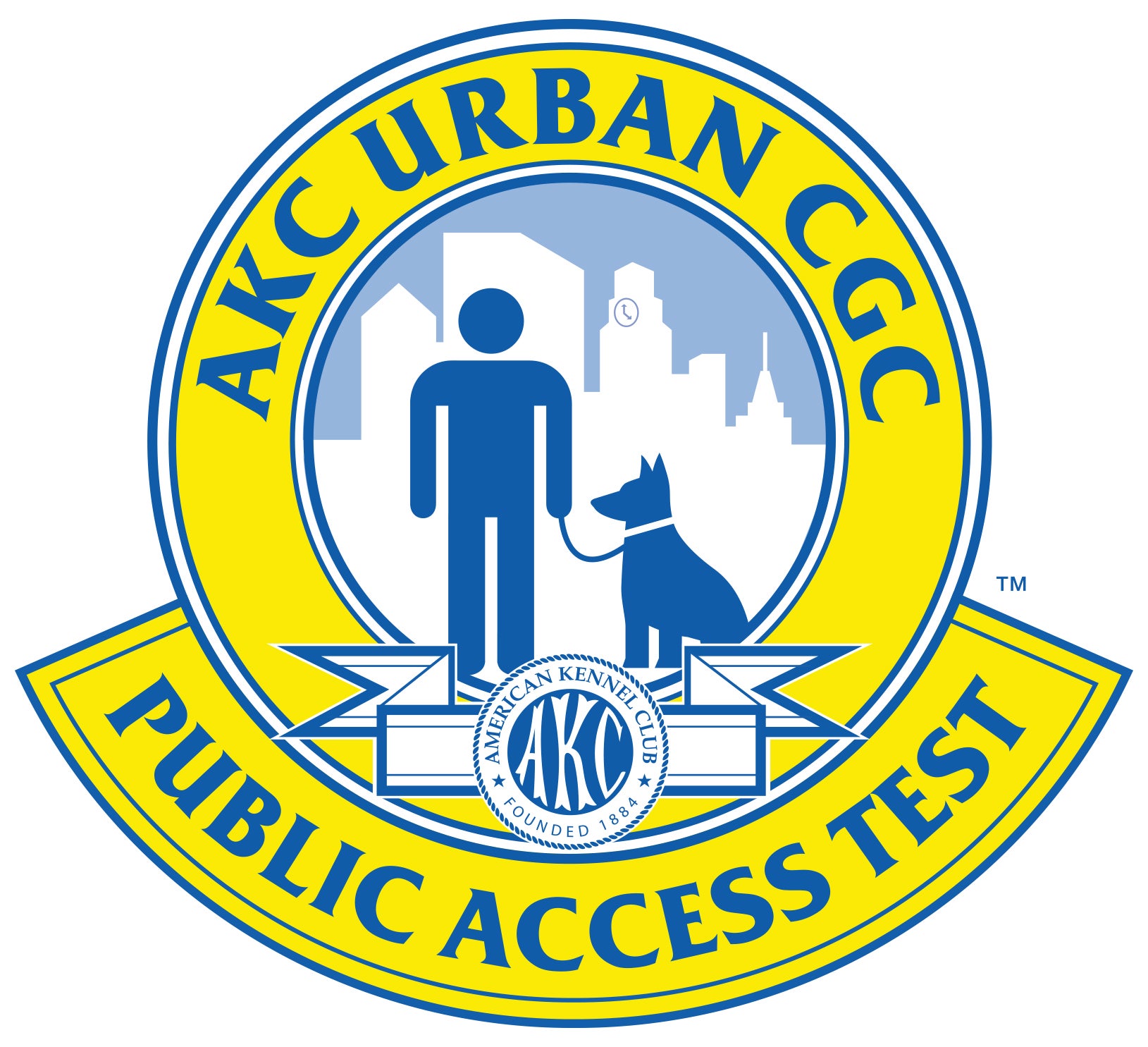Pups Path AKC Canine Good Citizen Class (Level 1) AND AKC Community Canine Good Citizen (Level 2) AND AKC Urban Canine Good Citizen
15 Sessions
Passing the Urban CGC test or Canine Good Citizen test does not make a dog a service dog or emotional support dog. A key distinction of service or emotional support dogs is that the owner/handler has a disability. It is unethical to misrepresent a pet dog as a service or emotional support animal.
What is Canine Good Citizen (CGC)?
At the AKC, we believe that all dogs can be good dogs, and all owners can be great owners, all it takes is a little bit of training, lots of love, and of course, plenty of praise along the way.
That’s why we created the Canine Good Citizen™ (CGC) program: an expert-made training program designed to help you and your dog be the best you can be–together.
Canine Good Citizen is a 10-skill test that teaches good manners to dogs and responsible dog ownership to their owners.
Canine Good Citizen Test Included At The End Of The Course
1. Accepting a friendly stranger
Evaluator approaches and pretends to shake hands with handler (hands 6- 12” apart). Evaluator does not touch dog.
2. Sitting politely for petting
Evaluator pets dog; dog must show no shyness or resentment.
3. Appearance and grooming
Evaluator inspects dog, combs or brushes lightly, examines ears and each front foot.
4. Out for a walk
Handler takes dog for a short walk including right turn, left turn, about turn and stop.
5. Walking through a crowd
Dog and handler walk close to several people; dog may show causal interest but not jump up.
6. Sit and down on cue/Staying in place
Handler shows that dog can do both sit and down, then chooses a position, leaves dog and goes to the end of a 20 ft. line, and returns immediately.
7. Coming when called
With dog still on 20 ft. line from Test 6, handler walks out 10 ft. and calls the dog.
8. Reaction to another dog
Two handlers and dogs approach, pretend to shake hands (hands 6-12” apart), exchange pleasantries, then move on.
9. Reaction to distractions
Distractions are presented; dog may not panic or show aggression.
10. Supervised separation
Handler goes out of sight for 3-min. Dog is held on a 6-ft. leash by anWho Can Participate in CGC?
CGC is open to all dogs–purebred and mixed breed. There are no age minimums or limits for participating in the Canine Good Citizen program, because yes, you can always teach an old dog new tricks!
With that being said, we also know that training a puppy can be very different than training an adult dog. Check out our specialized training program for puppies, AKC S.T.A.R. Puppy, which teaches the basics to get your puppy off to a good start and is an excellent first in-person training class.
Prepare You and Your Pet For The AKC Canine Community Test - Test is FREE at the end of the course!
About the AKC Community Canine℠ Title
AKC Community Canine℠ is the advanced level of the AKC’s Canine Good Citizen Program. Dogs who pass the AKC Community Canine test earn the official AKC Community Canine title that is designated by the letters “CGCA” (Advanced CGC) on the dog’s title record.
Whereas Canine Good Citizen tests are most often tested in a ring and situations are simulated (e.g., 3 helpers serve as a “crowd”), the AKC Community Canine test is done in real situations including at shows, classes, and in the community.
AKC Approved CGC Evaluators administer the AKC Community Canine test.
AKC COMMUNITY CANINE TEST
Advanced Canine Good Citizen (the “CGCA” title)
To earn the CGCA title, the dog must:
- be registered or listed with AKC (AKC number, PAL, or AKC Canine Partners number) and,
- already have a Canine Good Citizen award/title on record.
Dogs must pass all 10 items of the test to receive the CGCA title.
- Dog stands, sits or lies down and waits under control while the owner:
- sits at the registration table and fills out paperwork, or,
- if the test is done in the community, dog waits while the owner sits and has a snack or visits with another person (e.g., at a park)
- Walks on a loose leash in a natural situation (not in a ring) — does not pull.
- left turn
- right turn
- stop
- fast and slow pace
- Walks on loose leash through a crowd:
- at a show or in class, this item is tested in a real crowd, not in a ring
- in the community, dog walks on sidewalk, through a crowd at a community fair, park, on a trail, through a busy hallway, etc.
- Dog walks past distraction dogs present; does not pull.
This item may be tested along with #3 if there are dogs in the crowd, etc.- at a show or class, dog walks by dogs waiting in the crowd–dogs 2 ft. apart
- in the community, dog walks by other dogs on a trail, sidewalk, in a hallway, etc.
- Sit-stay in small group (two other people with dogs, total of 3 people, 3 dogs in group).
- Dog allows person who is carrying something (backpack, computer bag, etc.) to approach and pet it.
“May I pet your dog?” (Item is placed on floor/ground before the person pets the dog) - “Leave it.” Dog walks by food and follows owner instructions, “Leave it.”
This can be food placed by the evaluator on the floor or ground in a food dish with a wire cover as in Rally. - Down or sit stay — distance (owner’s choice).
Dog is on 20–ft line, owner walks away with back to dog, picks up an item (e.g., backpack, training bag, clipboard, folder etc.) placed on the floor/chair/ground by the evaluator and returns to the dog. - Recall with distractions present (coming when called). Handler goes out 20–ft. **(off center) and calls dog.
Dog is on the 20–ft. line from #8 above.
- Dog will sit or stand stay (owner’s choice) while owner enters/exits a doorway or narrow passageway. Owner calls dog through door when ready.
Owner may also choose to:- send the dog through first and have the dog wait for the owner, or
- the owner may choose to have the dog go through the doorway at the owner’s side.
Whichever method is used, the dog must not pull the owner and must be under good control. Think of the handler having the leash in one hand and a cup of coffee in the other.
Doorway or gate can be real or simulated with ring gates, two chairs, or a natural passageway (e.g., entrance to trail) in the community.
AKC Urban CGC Test as a Public Access Test
AKC Urban CGC is a title in the Canine Good Citizen family of awards and titles that also include AKC S.T.A.R. Puppy, Canine Good Citizen and AKC Community Canine.
AKC Urban CGC requires that the dog demonstrate CGC skills and beyond in a setting that includes traffic, crowds, noises, smells and other distractions that are present in a city or town. As with Canine Good Citizen, AKC Urban CGC is a 10-step test of skills that dogs must pass to earn the official AKC Urban CGC title. This is a title that appears on the dog’s title record at AKC.
AKC Urban CGC is a public access test that demonstrates dogs are well-behaved and well-trained when in public settings. The Urban CGC test can be used by dog- friendly business (e.g., lodging, retail, transportation, public facilities) to recognize and accept dogs with good manners.
The Setting
All skills are tested on leash. AKC Urban CGC should be administered in a place where there are cars, streets to be crossed, noises, and distractions. This test is administered in the real world; it should not be simulated in a ring at a dog show.
When test items (such as riding on an elevator) are administered in public buildings, the buildings must be dog friendly or evaluators must have permission in advance from the business owners, managers, etc.
Requirements
To earn the AKC Urban CGC (CGCU) title, dogs must meet the following two requirements:
- 1. Must already have a Canine Good Citizen (CGC) certificate or title on record at AKC. If the CGC and CGCU are tested on the same day, both forms should be sent in the same envelope to AKC so that the CGC can be applied to the dog’s record first.
- 2. Must have an AKC number of one of 3 types (AKC registration number, Purebred Alternative Listing (PAL) number, or AKC Canine Partners number). All dogs, including mixed breeds, can get an AKC number. The reason for the AKC number requirement is that this is how we create titles at AKC; we attach the titles to the dog’s number. Read more information on getting an AKC number.
Collar, Leashes and Equipment
All tests must be performed on leash. Dogs should wear well-fitting buckle or slip collars (including martingales) or body harnesses. Body harnesses should not restrict the movement of the dog. Special training equipment such as pinch collars and head collars are not permitted. The leash should be made of either leather or fabric. Retractable leashes may not be used in the test.
We recognize that special training collars may be valuable equipment in the beginning stages of dog training, however, we feel that dogs are ready to be tested after they have been transitioned to a slip or buckle collar (body harnesses are also acceptable). If an evaluator is teaching classes and does not feel comfortable with one of the permitted collars, students may be required to take the test in the type of collar used in class (as long as it is permitted by AKC for testing). If the test is advertised for the general public, all of the permitted collar types and body harnesses should be allowed in the test.













